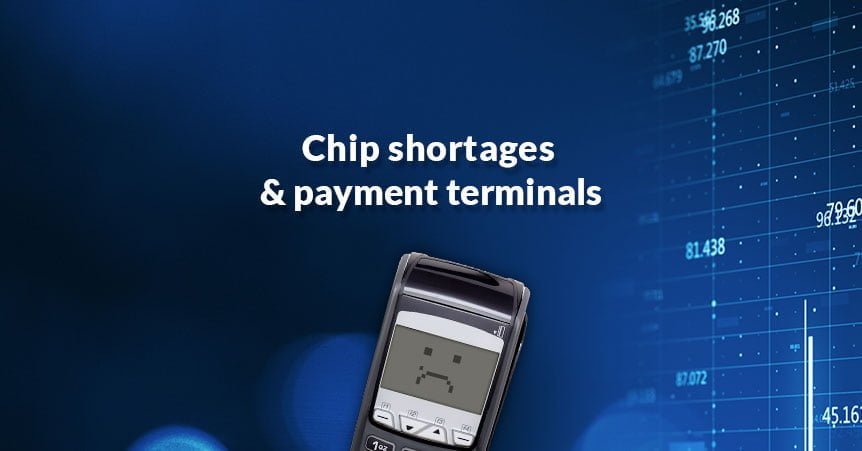Moving forward, the demand for semiconductors continues to outpace supply, and the firms that build automobiles are no longer the only ones feeling the pain from this trend. In many respects, microchips are the lifeblood of the contemporary economy since they power computers, cellphones, automobiles, appliances, and a multitude of other electronic devices. Hence, the payments industry makes no exceptions, being equally impacted by the global chip shortages with terminal production decreasing significantly.
According to the most recent “Global POS Market Tracker and Forecast” by Counterpoint Research, shipments of point-of-sale (POS) devices are estimated to reach 270 million units by 2025, with a CAGR of 19 %. Microchips play a significant role in producing various types of payment terminals. Overall, X payment terminals produced every n-period of time, translating into X components and chips needed to manufacture each one.
Uncovering the Global Chip Shortage
Overall, the prolonged nature of the chip shortages may be attributed to a single overarching element, which is a tremendous increase in demand. This spike in demand was driven by the digital transition, and it was hastened by the pandemic. Across many end markets, the lack of a single crucial chip, which typically costs less than a dollar, may impede the sale of tens of thousands of dollars’ worth of equipment. Deloitte estimates that the chip scarcity over the previous two years has led to revenue losses of more than US$500 billion globally between the semiconductor industry and its customers, including more than US$210 billion in missed vehicle sales in 2021 alone.
Considering that over 3 billion new EMV cards are generated annually, the prospect that the worldwide chip shortages may impact the payment card industry – which includes card suppliers, issuing banks, merchants, payment processors, acquiring banks, card networks, and consumers – is real and worrying.
Modern payment cards, also known as EMV chip cards, have memory chips and microprocessors that store data and allow the card to communicate with devices such as ATMs or card readers, such as point-of-sale (POS) terminals. These cards are also necessary for digital payments to function. According to EMVCo, there were 10,8 billion EMV chip cards in circulation worldwide by the end of 2020. EMVCo oversees the standards that allow card-based payment solutions to function together.
The situation is made even more complicated by the fact that there are shortages of crucial components, which may not be obvious to casual observers. One of them is a deficiency in the availability of packaging substrates, also known as the small interface layers found in packaged chips. Because of this scarcity, chip production has been severely hampered for some time now, resulting in lead times of at least one year.
Furthermore, although semiconductors are present in almost every facet of contemporary life, relatively few people are aware of the tremendous amount of carbon capital necessary for producing semiconductor chips, since the production and processing of semiconductor chips is a process that consumes a lot of energy and water and also generates hazardous waste.
For instance, the Taiwan Semiconductor Manufacturing Corporation Limited (TSMC), the biggest semiconductor manufacturing company globally, used about 63 million tons of water and 5% of Taiwan’s total electrical capacity during its operations. It is not only TSMC that is utilizing resources to such an intense degree; other chip manufacturers are doing the same thing. Large semiconductor manufacturers such as Intel and Samsung, amongst others, are experiencing the same issues.
Transitioning from Payment Terminals
Due to viable alternatives, payment terminals produced today are considered obsolete gadgets that do not need mass production. Today, many stakeholders recognize the value of “frictionless” technology, which streamlines the payment process by eliminating procedures, such as credit card swiping, that might hinder trade or provide disconnected client experiences. The adoption of frictionless payment technologies, such as mobile apps and wallets, contactless cards, and near-field communications (NFC), has enabled merchants to provide seamless checkout experiences, increase the number of completed payments, and boost sales, in addition to providing contactless options in the wake of the COVID-19 pandemic.
One of the most popular and innovative payment options is represented by Tap to Phone, one of the newest contactless payment processing solutions on the market. Leveraging the latest generation technology in smartphones that are always updated by the makers and tapping into phone technology providers without being unduly dependent on microchips since smartphones are an essential gadget in the present world.
This advances the current payment landscape by making the acceptance of payments less formal and more convenient while also enhancing payment processing alternatives. Both the integrity of the Tap on Phone payment application on the mobile device and the integrity of the host system are essential for ensuring the security of transaction data and preventing data breach situations.
Since actual POS terminals are not necessary anymore, the Tap to phone setup is quite straightforward. Users may simply download an application that is compatible with their tap to phone acquirer. Then, individuals may conveniently pay with a swipe of their smartphone’s credit card. According to a recent poll, just 16 % of customers now carry cash, and 58 % want to completely abandon its use. Merchants must be prepared to take card and mobile wallet payments, since fewer customers are carrying cash.
Bottom Line
Considering the plethora of challenges imposed by the current chip shortages and reduced payment terminals production, the Tap to Phone alternative emerges as one of the most convenient and viable alternatives for payment transactions. Overall, adopting Tap to Phone may encourage progress by introducing new methods to do routine chores, such as receiving payments, and making the process more casual, engaging, and simple to complete.
